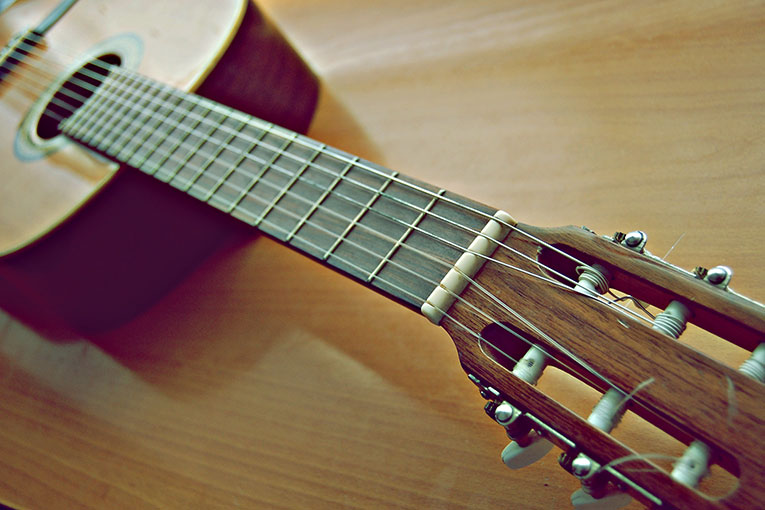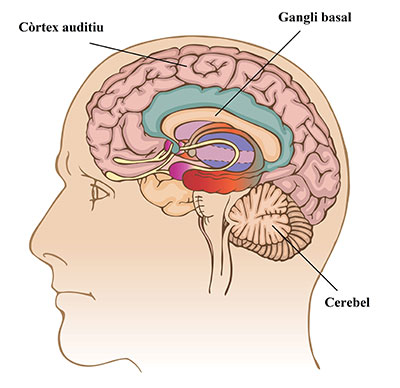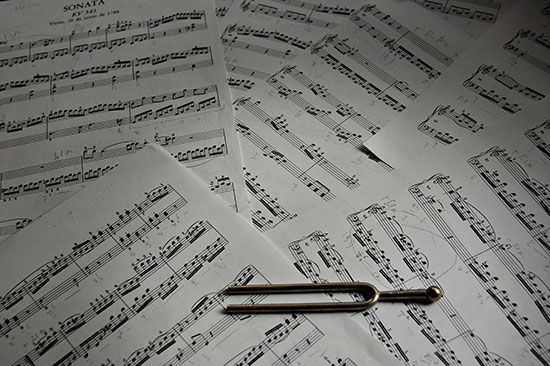
 Teresa Ciges Teresa CigesIt seems clear that music plays a vital role in our lives. But what do we know? |
||
|
Friedrich Nietzsche said life would be a mistake without music. Franz Liszt said that music is the heart of life. Even Albert Einstein once said that were he not a physicist, he would probably be a musician, and explained that his violin was what brought more joy to his life. It seems clear that music plays an essential role in our lives. But what do we know? How does it affect us? What happens in our brains when we listen to it? Did it enter our genome? In other words: are we humans innate musical creatures? The oldest way of communicating? In 1781, three years after the death of Rousseau, Essay on the Origin of Languages was published, which embodied the idea that there was a single precursor for language and music, and reconstructed the first language as a sort of song. Darwin also referred to this idea by explaining that music was an ancient and important form of human communication, intertwined with language yet depending on it. Neurologist Steven Brown described a musilanguage, a common ancestor for music and language. According to Brown, the many common features between music and language indicate the common origin of two different specializations born of the same system of communication of emotions. Steven Mithen supports a similar concept to musilanguage. He thinks music and language both developed from a single versatile communication system, one that could express many different things: the Hmmmm system. Hmmmm stands for holistic, multimodal, manipulative and musical. When humans started walking on two legs, Hmmmm must have given life to a language based on word combination. And what was left of that became music. Currently a separation between music and language is argued, a thesis supported, inter alia, by music’s priority in development. From a very early age, children show interest and sensitivity to rhythm and melody in spoken language, before they can understand the meaning of words. In fact, we currently know there is a separation in the brain between linguistic and musical abilities, although they are connected, proving that musical ability can be present in the brain even when language is absent. The brain: a genuine musical instrument One cannot avoid wondering exactly what happens in our brain when we listen to a song. First, sound waves reach the eardrum and make them vibrate. Along with them, the ear bones and a structure within the cochlea called basilar membrane also vibrate. This structure is very important because it is where the transformation of mechanical vibration into electrical impulses occurs. An important aspect is that the frequencies that form the sound are transmitted by different nerves. The information of decomposed sound must get together again to represent different voices and instruments, and science has not been able to explain how this happens yet. So far, we have identified a number of structures involved in this process: some subcortical (including the basal ganglia and cerebellum) and other cortical (particularly the auditory cortex). When we hear songs with lyrics, structures responsible for processing language are also involved. There are, in addition, structures involved in memory, emotion or cognition processes and complex motor processes that synchronize the rhythm of music and brain, and allow us, for example, to dance. |
«Rousseau’s essay embodied the idea that there was a single precursor for language and music, and reconstructed the first language as a sort of song» |
|
 Teresa Ciges Teresa CigesStructures involved in the decomposing process of sound: auditory cortex, basal ganglia and cerebellum. |
«From a very early age, children show interest and sensitivity to rhythm and melody in spoken language, before they can understand the meaning of words» |
|
|
It is also important to note that as melody and lyrics are stored in separate – but connected – places in our brain, every time we hear a known song, two interconnected neural systems come into play: the melodic analysis system, which activates the stored memory of the music, and the linguistic analysis system, which recovers the lyrics. When we repeatedly listen to a song we create strong neural links between both systems, so the activation of one of them will automatically stimulate the activation of the other. Research confirms that songs are better recognized than purely instrumental melodies, since memorizing songs establishes a more extensive brain information network, because it involves the management of at least two systems. Although neuroscience is a relatively unexplored field, today we can say that neural networks that process tone and rhythm are different. While the melody activates both brain hemispheres in the same way, harmony requires greater activity in the left hemisphere and rhythm basically activates the cerebellum. We also know that music neural networks are activated differently in a professional musician’s brain than in non-musicians’: for musicians, the left superior temporal gyrus is activated; for the rest, it is the right superior temporal gyrus. In short, music bounces through our body, is perceived by our senses and decoded by our brain. It is no wonder that now many researchers believe the neuroscience of music may provide very valuable information about the way the brain works. In the words of scientist and broadcaster Phillip Ball, «no other stimulus comparably engages all aspects of our mental apparatus, and compels them to speak with one another: left to right hemisphere, logic to emotion». The stenography of emotion There is a great bond between music and emotions. Musicologist Deryck Cooke analysed the connection between tonal scale and emotions, and concluded that, for example, the major third interval is an expression of pleasure or happiness. Therefore it became the basis for Beethoven’s Ninth Symphony or La Traviata. In contrast, the minor third interval generates painful emotions such as the ones we experience listening to the first movements of the Fifth Symphonies by Beethoven, Mahler and Tchaikovsky. But not only the intervals play a key role in the transmission of emotion through music. Vitalising agents such as intensity, rhythm, tempo and tone are also of a great importance. For example, the louder the music is played, the more emphasis is given to emotion. Similarly, the joy transmitted by a certain progression of tonal tensions can be tumultuous (allegro), calm (moderato), serene (adagio), hysterical (presto) or resigned (lento), among many other moods. With these data we can conclude that music has the ability to help change our mood. In fact, Stefan Koelsch, professor of Psychology of Music, claims music is able to evoke the core of responsible and creative brain structures in our emotional universe. The potential therapeutic applications of this present an obvious interest, allowing to help patients with brain structures disorders related to emotions. |
«Music is a community activity in every culture and throughout history. In fact, it helps the collective endeavour facilitating physical coordination through rhythm» |
|
 Teresa Ciges Teresa CigesSteven Mithen argues that music entered the human genome during the historical evolution of our species. |
«It is not absurd to say that the reason why we all love music is, to a greater or lesser extent, evolutionary heritage» |
|
|
Social glue Music is a community activity in every culture and throughout history. In fact, it helps the collective endeavour facilitating physical coordination through rhythm. Phillip Ball argues that music is a social glue that connects people. This is not just a conjecture. Evolutionary psychologist Robin Dunbar realised community musical activity causes waves of endorphins in the brain of the participants, making them feel better. Making music is a simple and inexpensive way of interaction, which can prove the willingness to cooperate and may encourage future collaboration. Musician and scientist William Benzoni explains that «music is a means through which individual brains are attached to a shared activity». That is why neurobiologist Walter Freeman described music as «biotechnology of group formation». To the sound of Darwin Now we consider the role of music in human evolution. According to evolutionary psychologist Steven Pinker, music fulfils many of the classic criteria for a complex biological adaptation in our species: it is universal for all cultures and in every period of recorded history. Therefore, it is not absurd to say that the reason why we all love music is, to a greater or lesser extent, evolutionary heritage. Also Darwin considered music in his book The Descent of Man, and Selection in Relation to Sex, in which he applied the logic of sexual selection to explain the origin of music. «[I]t appears probable that … before acquiring the power of expressing their mutual love in articulate language, [our ancestors] endeavoured to charm each other with musical notes and rhythm», he wrote. Contrary to those who postulate that music is just entertainment, there are many facts that prove that it is too different from language to be explained as a mere evolutionary derivation. Thus, some experts like Steven Mithen have claimed that music entered the human genome during the historical evolution of our species. He is not the only one, though. Psychologist Aniruddh Patel claimed that we are a musical species, because our musical abilities come from the moment when the common ancestors of humans and chimpanzees evolved into two different branches, about five million years ago. Are we innate musical creatures? Stefan Koelsch said that we are innate musical creatures from the depths of our nature, and adds that there is a good reason for this, because music allows us to perform all social functions, but we also need these capabilities to talk. In fact, Koelsch explains that when we are born we do not know what milk or drink mean, but we learn to speak by listening to the musical sounds of language. In addition, we developed an intuitive and shared tonal understanding about what music is. For Steven Mithen, it depends on an innate musical competence. In fact, throughout history we have used music to explore our evolutionary past. Evolutionary psychologist Ian Cross goes even further and claims that predisposition for musical activities is part of our biological heritage. Therefore, we can say that we have a musical instinct, that music has been incorporated into our genome. We are all born with a universal inclination towards music. It is consolidated in our early years and becomes a sensitivity and admirable taste for it. |
||
|
References Teresa Ciges. Journalist (Valencia). |
||





